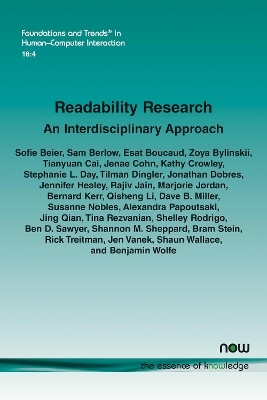
Readability Research
An Interdisciplinary Approach
Seiten
2022
now publishers Inc (Verlag)
978-1-63828-130-6 (ISBN)
now publishers Inc (Verlag)
978-1-63828-130-6 (ISBN)
Provides a comprehensive introduction to interdisciplinary methodologies, tools, and materials required for readability research focused on the individual reader. Contributors study the interactions between text, user, and task; and build the tools and interfaces needed to improve reading outcomes for all.
From the moment we wake up to the moment we end our day, we use interfaces built out of the written word. Textual information remains now, as it has for centuries, the cornerstone of human information acquisition. The wide adoption of smartphone, tablets, e-readers and personal computers has shifted the bulk of this reading from inflexible paper to digital content. The control provided by digital displays over how visual information is presented to readers has the potential to improve reading for each and every reader, regardless of ability or diagnosis. This represents a profound shift in how we think about reading because text is no longer rendered immutable by writers, designers, or publishers at a single stage, and human-computer interaction research is key to realizing its potential. Readability research takes a fundamentally individual approach to what each reader needs. Each reader has their own individual needs. Meanwhile, adapting the written word to the individual reader has never been easier, and the goal of maximizing individual reading efficacy is increasingly attainable. No one discipline or field has all the tools or answers, and readability work is inherently interdisciplinary. The authors of this monograph include vision scientists, technology experts, educators, designers, typographers, and data scientists. Together they represent voices from academia, the tech industry, and non-profit institutions, driven by common goals to improve the reading interfaces of today. In this review, they provide a comprehensive introduction to interdisciplinary methodologies, tools, and materials required for readability research focused on the individual reader. They call on the HCI community to contribute to the growing understanding of readers’ needs; to study the interactions between text, user, and task; and to build the tools and interfaces needed to improve reading outcomes for all.
From the moment we wake up to the moment we end our day, we use interfaces built out of the written word. Textual information remains now, as it has for centuries, the cornerstone of human information acquisition. The wide adoption of smartphone, tablets, e-readers and personal computers has shifted the bulk of this reading from inflexible paper to digital content. The control provided by digital displays over how visual information is presented to readers has the potential to improve reading for each and every reader, regardless of ability or diagnosis. This represents a profound shift in how we think about reading because text is no longer rendered immutable by writers, designers, or publishers at a single stage, and human-computer interaction research is key to realizing its potential. Readability research takes a fundamentally individual approach to what each reader needs. Each reader has their own individual needs. Meanwhile, adapting the written word to the individual reader has never been easier, and the goal of maximizing individual reading efficacy is increasingly attainable. No one discipline or field has all the tools or answers, and readability work is inherently interdisciplinary. The authors of this monograph include vision scientists, technology experts, educators, designers, typographers, and data scientists. Together they represent voices from academia, the tech industry, and non-profit institutions, driven by common goals to improve the reading interfaces of today. In this review, they provide a comprehensive introduction to interdisciplinary methodologies, tools, and materials required for readability research focused on the individual reader. They call on the HCI community to contribute to the growing understanding of readers’ needs; to study the interactions between text, user, and task; and to build the tools and interfaces needed to improve reading outcomes for all.
1. Introduction
2. Types of Reading
3. Readers
4. Reading Materials
5. Equipment, Devices, and Software Tools
6. Experimental Methodologies
7. Data Analysis for Readability Studies
8. Looking to the Future of Readability Research
Appendices
Acknowledgements
References
| Erscheinungsdatum | 19.12.2022 |
|---|---|
| Reihe/Serie | Foundations and Trends® in Human-Computer Interaction |
| Verlagsort | Hanover |
| Sprache | englisch |
| Maße | 156 x 234 mm |
| Gewicht | 189 g |
| Themenwelt | Informatik ► Software Entwicklung ► User Interfaces (HCI) |
| ISBN-10 | 1-63828-130-0 / 1638281300 |
| ISBN-13 | 978-1-63828-130-6 / 9781638281306 |
| Zustand | Neuware |
| Haben Sie eine Frage zum Produkt? |
Mehr entdecken
aus dem Bereich
aus dem Bereich
Aus- und Weiterbildung nach iSAQB-Standard zum Certified Professional …
Buch | Hardcover (2023)
dpunkt Verlag
CHF 48,85
Lean UX und Design Thinking: Teambasierte Entwicklung …
Buch | Hardcover (2022)
dpunkt (Verlag)
CHF 48,85
Wissensverarbeitung - Neuronale Netze
Buch | Hardcover (2023)
Carl Hanser (Verlag)
CHF 48,95


